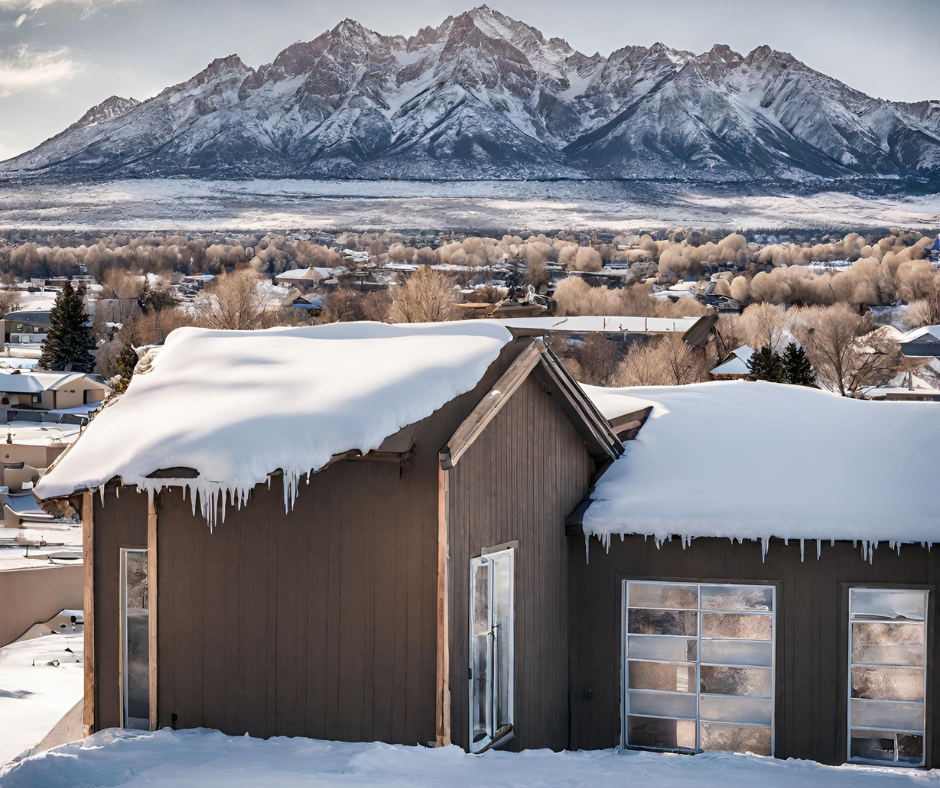
As winter arrives, it brings with it the potential for roofing troubles. The last thing any homeowner wants during the colder months is a leaky roof or the formation of ice dams. With 551 inches of snowfall in Utah occurring annually, it is recommended to do preventative measures to keep your roof safe. If you do need winter roof repair, our experts are here to help!
Understanding Ice Dams and Leaks
Ice dams are ridges of ice that form at the edge of a roof and prevent melting snow from draining off properly. As a result, the water can back up under the shingles, causing leaks and potential damage to the interior of your home.
One of the main causes of ice dams is inadequate attic insulation and ventilation. When your attic is poorly insulated, heat from your home can escape and warm up the roof, causing the snow to melt. As the melted snow reaches the colder edges of the roof, it refreezes, creating ice dams. It’s important to address any insulation issues to prevent this cycle from occurring.
A heavy snowfall combined with a lack of proper roof maintenance can lead to ice dams. The weight of the snow can put stress on your roof, causing it to weaken over time. Regularly clearing snow off your roof is essential in preventing ice dams and protecting the structural integrity of your home.

The Importance of Winter Roof Maintenance
Maintaining your roof during the winter is crucial in preventing ice dams and leaks. While homeowners can climb up on the roof and inspect it, we don’t always recommend it due to safety concerns. We do provide roof inspections and a member of the A1 Roofing team would be happy to come out and check for concerns.
Some of the common things we search for when inspecting a roof include:
- Cracked shingles
- Loose flashing
- Deteriorating seals
- Attic insulation
- Roof ventilation
Signs of Ice Dams and Leaks
Some common signs of ice dams include icicles hanging from the edge of your roof, water stains on your ceiling or walls, and the sound of dripping water. You may also notice damp or moldy areas in your home. If left untreated, roof leaks can lead to structural damage and costly repairs.
Insulating Your Attic to Prevent Ice Dams
Insulating your attic helps to keep the heat inside your home, reducing the risk of snow melting on your roof. Adding insulation to your attic floor and walls can significantly improve energy efficiency and prevent ice dams from forming.
Using Heat Cables to Prevent Ice Dams
Heat cables are another effective tool in preventing ice dams. These cables are installed along the edge of the roof and in the gutters to provide heat, melting any snow or ice that accumulates. You can install the heat cables with a thermostat so they can automatically turn on when it starts to freeze.
How to Deal with Ice Dams and Leaks
If you already have ice dams or leaks, address them quickly. Here are some steps you can take:
- Identify the source of the problem: Look for signs of water damage inside the attic. Do you notice if the insulation is wet? If you can see water dripping down the interior of the attic, call our team immediately. Water damage of this level needs to be addressed as soon as possible to prevent further damage.
- Remove the ice dams: Use a roof rake or hire a professional to safely remove the ice dams from your roof. Do not attempt to chip away at the ice with sharp objects, as this can cause damage to your roof!
- Address the leaks: Once the ice dams are removed, assess the extent of the damage caused by the leaks. Repair any damaged shingles, flashing, or seals.
- Improve insulation and ventilation: Measure the insulation levels in your attic. If you do not have any leaks, it may be a good time to add some additional insulation if needed. Weatherization rebates in Utah are a great way to upgrade your home for a lower cost, or free for qualified homes.
How to Add Heat Cables to Your Roof
Heat cables, also known as heat tape, are electrical devices that generate heat to melt the ice and snow on your roof. They are typically installed along the roof edges, gutters, and downspouts, creating a path for the water to flow freely. Here’s how you can use heat cables to prevent ice dams:
- Look for damage: Before installing heat cables, it’s crucial to inspect your roof to identify the areas prone to ice dams. Look for signs of previous ice dam formations, such as icicles, water stains on the walls, or peeling paint.
- Choose the right heat cables: There are different types and sizes of heat cables available in the market. Consider the length of your roof edges, gutters, and downspouts to determine the required length of heat cables. It is important to check the rating of heat cables, some are not meant for Utah weather.
- Install the heat cables: Start by attaching the heat cables to the roof edges using clips or fasteners. Follow the manufacturer’s instructions for proper installation, so that the cables are evenly spaced and securely attached. Connect the cables to a power source, keeping in mind the electrical safety guidelines.
It is important to note that heat cables are not a permanent solution and should be used in conjunction with other preventive measures to prevent ice dams on your roof.
Winter Roof Repair in Utah
Even with preventive measures, ice dams can still form on your roof during winter. Without proper care, ice dams will eventually pull the gutters from your home and leave you with expensive repairs in the spring. Call A1 Roofing if you need help with winter roof repair in Utah.


